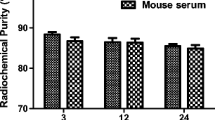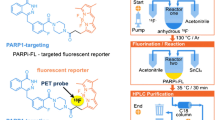Abstract
Purpose
In glioblastoma, EphB4 receptors, a member of the largest family of receptor tyrosine kinases, are overexpressed in both tumor cells and angiogenic blood vessels. The purpose of this study was to examine whether the EphB4-binding peptide TNYL-RAW labeled with both 64Cu and near-infrared fluorescence dye Cy5.5 could be used as a molecular imaging agent for dual-modality positron emission tomography/computed tomography [PET/CT] and optical imaging of human glioblastoma in orthotopic brain tumor models.
Materials and Methods
TNYL-RAW was conjugated to Cy5.5 and the radiometal chelator 1,4,7,10-tetraazadodecane-N,N′,N″,N‴-tetraacetic acid. The conjugate was then labeled with 64Cu for in vitro binding and in vivo dual μPET/CT and optical imaging studies in nude mice implanted with EphB4-expressing U251 and EphB4-negative U87 human glioblastoma cells. Tumors and brains were removed at the end of the imaging sessions for immunohistochemical staining and fluorescence microscopic examinations.
Results
μPET/CT and near-infrared optical imaging clearly showed specific uptake of the dual-labeled TNYL-RAW peptide in both U251 and U87 tumors in the brains of the nude mice after intravenous injection of the peptide. In U251 tumors, the Cy5.5-labeled peptide colocalized with both tumor blood vessels and tumor cells; in U87 tumors, the tracer colocalized only with tumor blood vessels, not with tumor cells.
Conclusions
Dual-labeled EphB4-specific peptide could be used as a noninvasive molecular imaging agent for PET/CT and optical imaging of glioblastoma owing to its ability to bind to both EphB4-expressing angiogenic blood vessels and EphB4-expressing tumor cells.







Similar content being viewed by others
References
Furnari FB, Fenton T, Bachoo RM et al (2007) Malignant astrocytic glioma: genetics, biology, and paths to treatment. Genes Dev 21(2):683–710
Wen PY, Kesari S (2008) Malignant gliomas in adults. New Engl J Med 359:492–507
Murai KK, Pasquale EB (2003) ‘Eph’ective signaling: forward, reverse and crosstalk. J Cell Sci 116:2823–2832
Flanagan JG, Vanderhaeghen P (1998) The ephrins and Eph receptors in neural development. Annu Rev Neurosci 21:309–345
Boyd AW, Lackmann M (2001) Signals from Eph and ephrin proteins: a developmental tool kit. Sci STKE 2001:re20
Holder N, Klein R (1999) Eph receptors and ephrins: effectors of morphogenesis. Development 126:2033–2044
Cheng N, Brantley DM, Chen J (2002) The ephrins and Eph receptors in angiogenesis. Cytokine Growth Factor Rev 13:75–85
Durbin L, Brennan C, Shiomi K et al (1998) Eph signaling is required for segmentation and differentiation of the somites. Genes Dev 12:3096–3109
Pasquale EB, Deerinck TJ, Singer SJ, Ellisman MH (1992) Cek5, a membrane receptor-type tyrosine kinase, is in neurons of the embryonic and postnatal avian brain. J Neurosci 12:3956–3967
Dodelet VC, Pasquale EB (2000) Eph receptors and ephrin ligands: embryogenesis to tumorigenesis. Oncogene 19:5614–5619
Easty DJ, Herlyn M, Bennett DC (1995) Abnormal protein tyrosine kinase gene expression during melanoma progression and metastasis. Int J Cancer 60:129–136
Kiyokawa E, Takai S, Tanaka M et al (1994) Overexpression of ERK, an EPH family receptor protein tyrosine kinase, in various human tumors. Cancer Res 54:3645–3650
Wicks IP, Wilkinson D, Salvaris E, Boyd AW (1992) Molecular cloning of HEK, the gene encoding a receptor tyrosine kinase expressed by human lymphoid tumor cell lines. Proc Natl Acad Sci U S A 89:1611–1615
Erber R, Eichelsbacher U, Powajbo V et al (2006) EphB4 controls blood vascular morphogenesis during postnatal angiogenesis. EMBO J 25:628–641
Koolpe M, Burgess R, Dail M, Pasquale EB (2005) EphB receptor-binding peptides identified by phage display enable design of an antagonist with ephrin-like affinity. J Biol Chem 280:17301–17311
Kumar SR, Scehnet JS, Ley EJ et al (2009) Preferential induction of EphB4 over EphB2 and its implication in colorectal cancer progression. Cancer Res 69:3736–3745
Kumar SR, Singh J, Xia G et al (2006) Receptor tyrosine kinase EphB4 is a survival factor in breast cancer. Am J Pathol 169:279–293
Nakamoto M, Bergemann AD (2002) Diverse roles for the Eph family of receptor tyrosine kinases in carcinogenesis. Microsc Res Tech 59:58–67
Pasquale EB (2005) EPH receptor signaling casts a wide net on cell behavior. Nat Rev Mol Cell Bio 6:462–475
Xia G, Kumar SP, Stein JP et al (2006) EphB4 receptor tyrosine kinase is expressed in bladder cancer and provides signals for cell survival. Oncogene 25:769–780
Xiong CY, Huang MA, Zhang R et al (2011) In vivo small-animal PET/CT of EphB4 receptors using Cu-64-labeled peptide. J Nucl Med 52:241–248
Zhang R, Xiong CY, Huang M et al (2011) Peptide-conjugated polymeric micellar nanoparticles for Dual SPECT and optical imaging of EphB4 receptors in prostate cancer xenografts. Biomaterials 32:5872–5879
Wang W, Ke S, Kwon S et al (2007) A new optical and nuclear dual-labeled imaging agent targeting interleukin 11 receptor alpha-chain. Bioconjug Chem 18:397–402
Grinvald A, Frostig RD, Lieke E, Hildesheim R (1988) Optical imaging of neuronal activity. Physiol Rev 68:1285–1366
Gibson AP, Hebden JC, Arridge SR (2005) Recent advances in diffuse optical imaging. Phys Med Biol 50:R1–R43
Bremer C, Ntziachristos V, Weissleder R (2003) Optical-based molecular imaging: contrast agents and potential medical applications. Eur Radiol 13:231–243
Hielscher AH (2005) Optical tomographic imaging of small animals. Curr Opin Biotech 16:79–88
Licha K, Olbrich C (2005) Optical imaging in drug discovery and diagnostic applications. Adv Drug Deliv Rev 57:1087–1108
Niell CM, Smith SJ (2004) Live optical imaging of nervous system development. Annu Rev Physiol 66:771–798
Roessler K, Becherer A, Donat M et al (2012) Intraoperative tissue fluorescence using 5-aminolevolinic acid (5-ALA) is more sensitive than contrast MRI or amino acid positron emission tomography (18F-FET PET) in glioblastoma surgery. Neurol Res 34:314–317
Stummer W, Pichlmeier U, Meinel T et al (2006) Fluorescence-guided surgery with 5-aminolevulinic acid for resection of malignant glioma: a randomised controlled multicentre phase III trial. Lancet Oncol 7:392–401
Acknowledgments
We thank Erica Goodoff for editing the manuscript. This work was supported in part by the John S. Dunn Foundation. The small animal imaging facility of the University of Texas MD Anderson Cancer Center is supported in part by the National Institutes of Health through MD Anderson Cancer Center Support Grant CA016672.
Conflict of Interest
The authors declare that they have no conflicts of interest.
Author information
Authors and Affiliations
Corresponding author
Additional information
Miao Huang, Chiyi Xiong, and Wei Lu made equal contribution to this work.
Rights and permissions
About this article
Cite this article
Huang, M., Xiong, C., Lu, W. et al. Dual-Modality Micro-Positron Emission Tomography/Computed Tomography and Near-Infrared Fluorescence Imaging of EphB4 in Orthotopic Glioblastoma Xenograft Models. Mol Imaging Biol 16, 74–84 (2014). https://doi.org/10.1007/s11307-013-0674-3
Published:
Issue Date:
DOI: https://doi.org/10.1007/s11307-013-0674-3




